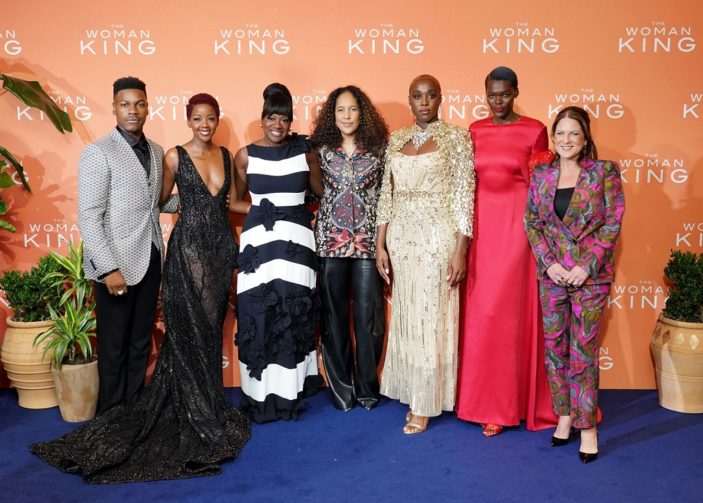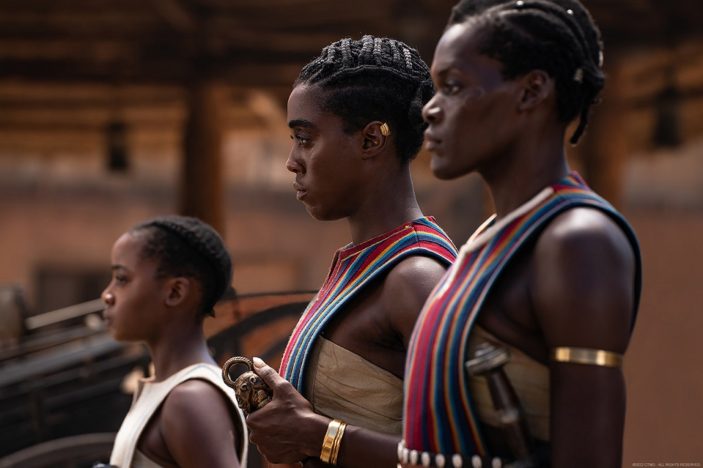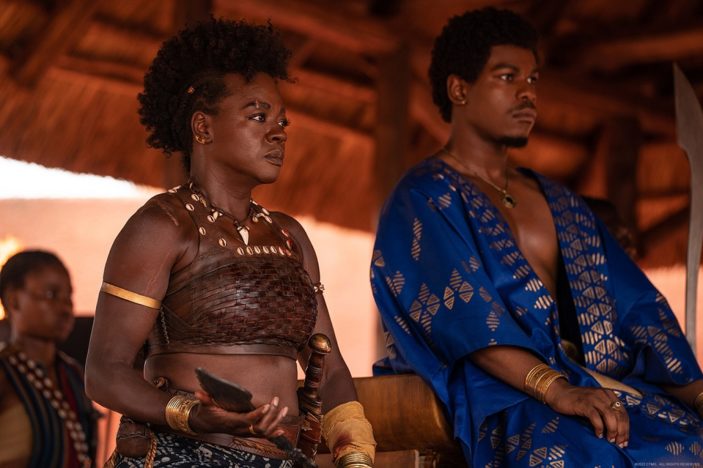
As The Woman King continues to dazzle Australian audiences, Peter Gray spoke with director Gina Prince-Bythewood and cast members Lashana Lynch, Sheila Atin and John Boyega ahead of its premiere at this year’s Toronto Film Festival.
Following on from his chat with Viola Davis and Thuso Mbedu, Peter discussed working together on location, the importance of seeing a predominantly black crew on set, and how grateful they all are to have worked with such a force as their leading lady.
The casting in the film is incredible and seemed very specific. Was everybody you sought out for this project ultimately cast?
Gina Prince-Bythewood: Yes, certainly. Viola Davis was attached when I came aboard. So that was a huge one, certainly. But when I read the script Lashana (Lynch) and John (Boyega) popped into my head immediately as two people I wanted in the film. And, you know, it’s a beautiful thing to know something so strongly and then it happens. Both came aboard and wanted to be a part of it. Sheila (Atin) and Thuso (Mbedu) came through auditions. Both of them are incredible actors that are not well known (and) I hope will be after this. But it was pretty clear really quickly that both of them needed to be a part of this film.
Was there any difficulty in filming on location? It so easily could have been a soundstage, so how was it to take on the challenges that come with the elements of such a shoot?
Gina Prince-Bythewood: It was just a decision that we made from the outset. We wanted to shoot on the continent, we wanted to be able to give this film the scope and epic feel that it deserved. You can’t do that with green screen. So we wanted to go where we could shoot 360. I wanted to give the actors a 360 environment to play in, which is what South Africa and KwaZulu-Natal gave us. And just on a personal emotional level for the actors, they wanted their feet in the soil. They wanted to feel the story of their ancestors on this continent. That fed everybody. Our crew was 90% South African, so they all had that passion to tell the story (too) and felt honoured by the opportunity to tell it at this size. It was an incredible environment to be in.
Sheila Atim: It was really wonderful. It’s very rare that you get the opportunity to shoot in or near the place that a project is set. Obviously, it’s set in West Africa, but we were able to be on the continent. We were on location for the majority of the shoot, so we were able to benefit from the landscape, from the actual Old Earth, the actual soil… the elements sometimes pose challenges, you know, you’re fighting for the light and you’ve got win and sand blowing in your eyes, but I think we all benefitted from it. I think the film benefits from it (too). I think you can really feel it through the screen.
For the industry over in Africa, for these production companies to be able to benefit from having large scale productions come to their countries and employing all of those people… to be able to see that many Black and African people behind the camera, as well as in front of the camera, to work alongside these people is just so hugely important. So often black people have been syphoned off into one corner when it comes to this industry, and I really felt this was an opportunity to expand on that.

There’s such a physicality to this film, but it’s also very emotional and peppered with humour throughout too. Was there a lot of time for this cast to bond, Gina? It all came across so naturally on screen.
Gina Prince-Bythewood: Yeah, a beautiful part of the rehearsal process for me is to create bond, real organic bonds, between the actors that then, as you said, can show up on screen. Of course, actors can act like they like each other, but there’s intangible things that happen when you truly care about somebody that show up. So, the whole rehearsal process, in addition to all the working out, was to build those friendships, those connections between them. The more that we did that, the deeper they got.
It was a beautiful thing to witness to see Lashana and Thuso. Their relationship on the page was cool, but what they brought was their connection, and it elevated that relationship of (their characters) Izogie and Nawi to where I started seeing how good their chemistry was and that we could write more for them. That’s the fun thing about being a director (is) you can stay open, and I knew that Lashana and Sheila were friends before, which I didn’t know when I cast them, but this experience made them even closer. In the original script (their characters) didn’t have a relationship, so I started putting them in together to see what would happen. Now, Amenza (Sheila’s character) has a real drive as to what she’s going to do, so everything you see on screen was real off-screen.
On that physicality, it’s so fierce yet so beautiful. Lashana and Sheila, did your previous experience in the action genre inform you of any of the movements here? Or was it a new dynamic here with all the intricate choreography?
Lashana Lynch: I think a little bit of both. It’s nice to have entered the world and had a taste, because even though, yes, we’ve been a part of physical films, being able to do your own stunts for an entire film is a different experience that I can’t liken to anything else, actually. I feel really grateful that I’m physical. I’ve played sports and go to the gym, and I thought that would be enough of a foundation, but it was not. It feels great to be able to be in physical command of your character, and to be able to shape them before you’ve even harnessed a script, which is not a given. When Gina asked me if I could do my own stunts, it kind of sends something up your spin when you’re asked that (laughs). But I’m glad I was able to rise to the challenge of it.
Sheila Atim: I think the beautiful thing about the opportunity to do your own stunts and be in a film that was this action heavy, is that there’s no ceiling in terms of how far you can push yourself. So, you know, my previous action experiences were limited by where the decision of my role would fit in. But I think for this project, they just said go for gold and keep pushing. It wasn’t a case of you only have to get to this level of fitness and then that’s it. We were constantly trying to increase our weight when we were training with Gabby Mclain, the personal trainer, we were constantly trying to up the complexity of the stunt choreography all the way through the five months. It was different in the sense that the horizon was really broad for what we were able to achieve and it really was just up to us to keep pushing the envelope.

The film is not just about female empowerment, but black female empowerment. Feels like you can’t get more powerful than Viola Davis. How was it working with her on a project as passionate as this?
Sheila Atim: Right? It was great, it really was everything I hoped it would be and more. And not just because she’s such a prominent and powerful figure of advocacy for black people and black women and artists. But because she’s a really nice person, and that is something that when you’re talking about empowerment or advocating for change that can sometimes get left out of the equation. It’s really important to just be interpersonal and be able to relate to people. To make them feel comfortable and welcomed and supported, and she was so brilliant at doing that for all of us. Particularly for the actors that were working with her and sharing scenes with her. For me, as a working actor, I don’t just want to create good work, I also want to have great experiences with the people I’m working with. And I’m really grateful I got that opportunity to collaborate with Viola because she’s definitely one of those people.
Lashana Lynch: There were many firsts on this shoot. Whether it be shooting on the continent for the first time, having a black cast for the first time, to have a black leader who is a real human being who is very, as (Sheila) said, interpersonal, who would look around when you’re going through something on set, struggling with a scene or emotionally, Viola would always be the one that would come with this strength. I don’t know where she pulls her strength from, but she pulls it from this magical place that really reverberates around the set. When morale was down or it’s been a long day, it’s incredible to look at your leader and draw strength from her, but also feel like you’re not taking it from her.
John Boyega: She was fantastic to work with. For me, I was really excited to just come on set and collaborate on the few things that we have (together). It’s always good to watch someone in that position show a selfless devotion to the art, and then a selfless devotion to even just spreading knowledge, because you actually don’t have to check your business. But she does. She will share that truth with you in order for you to learn. I wasn’t even speaking to her directly, she was speaking to some of the other younger actors, but, as we say in Nigeria, “My ear became big” (laughs) and I was listening and taking in that information. It’s great to be around.
The Woman King is now screening in Australian theatres.
